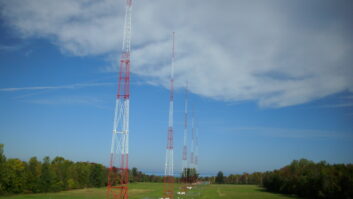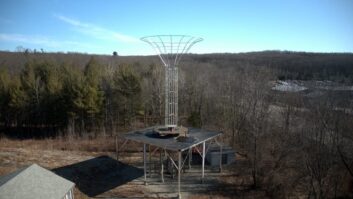Let�s face it. Civilians generally view engineers as wizards.
When they turn on the wireless at all hours of the day and night, music and voices ethereally float out from a small box.
Equally mysterious are the antennas we use in our trade, especially those for AM. Wait. All those towers together are the antenna? What do you mean part of the antenna is below ground? Yeah.
Usually, a system will have a ring and screen around the base of the tower where all of the radials are connected together. Check the integrity of this structure, including the brazed joints.

Thus far, nearly all of our AM topics have been in places where the sun shines. Now, we move to subterranean levels. We are not going as far below the surface as the land of H.G. Wells� Morlocks, but far enough below the dirt to be somewhat mysterious, and definitely mostly out of sight.
Unfortunately, out-of-sight usually means out-of-mind, and by extension, surprise problems.
The simplest antenna that can be constructed is a dipole, which structurally is a wire that is one-half wavelength long and connected in the middle to a transmission line. The standard non-directional AM antenna is a vertical design with a radiator above ground, and ground system below the surface of the site. Electrically, a vertical is a dipole with half its length buried in the ground, or comprising an above-ground counterpoise.
The standard such ground system consists of at least 120 radials of one-quarter wavelength. Fig. 8 of Section 73.190 of the Federal Communications Commission�s rules provides a graph of the effective field at 1 km for 1 kW using that type of ground system, while varying the vertical height of the radiator.
(Note that this is the commission�s standard system, and some stations, especially older ones, may have other configurations. There is no shortage of articles and discussions available concerning varying lengths and quantities of radials and their effects on efficiency. In general, more radials seem to be preferred over fewer at longer lengths.)
Installed ground systems typically require a small amount of maintenance if site conditions are good.
MANAGE CONDITIONS
Fence structural integrity should be carefully maintained, and the area immediately around the tower bases should be kept free of weeds and brush.

But tree and plant roots are common ground system destroyers. Consequently, the field around an AM antenna system should look just like a golf course fairway. Regular mowing and spraying will keep newly installed systems looking this way and will reduce damage to radial wires and ground straps. Roots from trees tend to grow radially from the trunk, and so ensure that an adequate buffer zone is present between trees at the edge of the radial field and the radials themselves.
Less common, but even more insidious to ground systems, are pipelines.
Pipeline product can carry small amounts of water and salts, which over time will corrode the internal structure of the pipe. Externally, an electrochemical reaction can occur due to soil content, moisture, and other structures in the vicinity corroding and pitting the pipeline from the outside inwards. To mitigate these effects, modern pipelines typically use an epoxy coating.
Additionally, they also employ a cathodic protection system, which electrically charges the pipeline. This forces other materials in the vicinity to corrode to the pipeline, instead of the pipeline itself corroding and spilling product.
The issue here for our ground system is the level to which the pipeline is charged, how well their sacrificial anodes are maintained and to what degree the epoxy coating on the pipeline is compromised. If aligned against our favor, we can find that our ground system is eaten away at a significant rate. This effect can be reduced by providing cathodic protection to the antenna ground system itself, through providing our own sacrificial anodes. This, of course, adds an additional layer of maintenance, in that the sacrificial anodes need to be checked regularly and replaced when needed.
In addition to pipeline cathodic protection, cathodic protection of guy anchors for towers can also pose a problem. That type of system seems to be much more popular and prevalent for larger guyed towers than AM arrays. However, if your facility uses these devices, be sure to keep a watchful eye on the ground system.
HOW TO SPOT PROBLEMS
The field around an AM antenna system shoulde look just like a golf course fairway � weed-free!

Developing issues with ground systems can usually be noted in a couple of ways. Since the ground system provides the current return path, as previously discussed, its proper functioning is directly tied to the radiation efficiency of the antenna, and by extension coverage.
In the March 2016 edition of this column, we touched on main lobe efficiency problems, and the fact that they may go undetected as a result of rule changes (Read it online here: https://tinyurl.com/yadeaxtj). Occasionally, spot-checking locations in the main lobe of coverage will provide seasonal trends to consider and may provide an indication of developing ground system problems.
Another way of seeing changes in ground system performance is through shifts in the antenna impedance. If you do not have a bridge or network analyzer handy, changes in impedance can be noted by antenna current shifts.
In a directional antenna, as long as the pattern has not shifted, you may observe changes in the current value, while the ratios between them should remain fairly constant. The impedance of a vertical antenna is tied to not only the radiator height, but also the quantity and length of ground radials. Ground conductivity can also impact, so if an issue is observed, consider the environmental conditions between measurement sets, and keep in mind that multiple data sets over an extended period of time may be necessary to determine an actual trend.
If there is a question over the integrity of the ground system, an inspection should be performed.
Usually, a system will have a ring and screen around the base of the tower where all of the radials are connected together. Check the visual integrity of this structure including the brazed joints. Tin-lead solder should never be used in this application, due to the location of both metals on the galvanic series, and the propensity for such joints to decay from chemical reactions in the soil. Rather, joints should be made by brazing with alloys that contain at least 5 percent silver.
Additionally, a check with a field strength meter can be performed. Holding the field strength meter close to the earth, as you pass over radials, you should see a slight deflection in the measured field strength. Move steadily outwards from the tower to ensure that the length of the radials has not been truncated, and dig as necessary to confirm their existence and location.
Of course, any construction at or in the vicinity of the site that may disturb radials should be closely examined.
In addition to physically identifying the extent of potential damage, it may also be illustrative to computer model the antenna system. Additionally, field and impedance measurements should be performed both prior to and following construction activities.
If locations are known ahead of time, identification of damage to radials should be straightforward. Repair of damaged radials is equally straightforward.
The surfaces of the wire should be well prepared and then brazed together. If the radials are large enough, a very elegant solution is to utilize a small section of copper tubing for the splice. This procedure can make a very strong physical connection that also avoids metal fatigue problems that can occur in the wire by bending and forming the physical connection prior to brazing.
In addition to radial breakage, damage to straps can also occur.
Such damage should be repaired through brazing, and not the permanent installation of a pair of fast release locking pliers. In this case, and all others where brazing is performed, consider using a carburizing or reducing oxyacetylene flame. With oxyacetylene sufficient heat is developed to easily flow the filler metal into the joint, and the ratio of fuel to oxygen can be controlled. In the carburizing flame, an excess of fuel is present, which prevents the base metal from being oxidized, thereby retaining much of its shiny appearance, reducing brittleness, and maintaining ductility.
Finally, here�s a cautionary tale.
I remember one engineer who attempted to increase the ground conductivity around the base of his station�s tower by purposely introducing salt into the soil. Apparently, he had read about people using a solution of magnesium sulfate (Epsom salts) around ground rods, and figured this would be good at the base of the tower. Since water softener salt, sodium chloride and/or potassium chloride, is used by people to kill weeds in sidewalk cracks, two birds would be killed with one stone. The problem is the ground system itself was killed, as were the next three or four installed over the ensuing decade.
In conclusion, ground systems are relatively simple, and maintaining them does not typically take much time. As long as you keep the site mowed, prevent people from plowing the ground, and periodically check impedances and field strengths, they should last for many years.
Ruck is the principal engineer of Jeremy Ruck and Associates, Canton, Ill.







